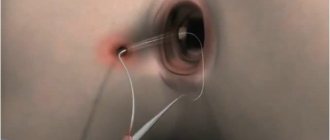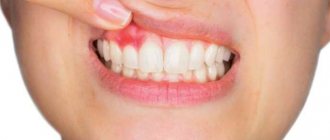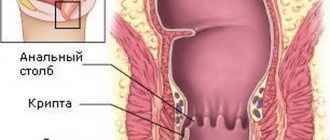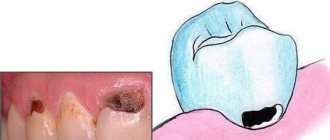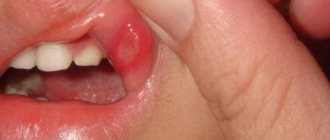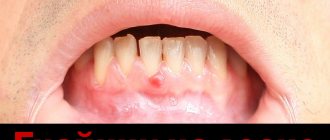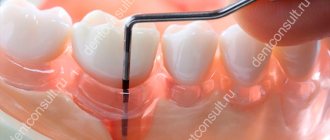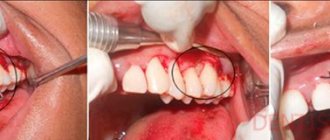Why does a hole appear on the gum?
In the oral cavity of any person there is a special microflora.
It consists of a huge number of species and types of microorganisms. If the body is healthy, there are no decayed teeth or intestinal problems, pathogenic bacteria are in a “sleepy” state and are easily suppressed by a strong immune system. Negative factors, stressful situations and improper hygiene can upset this delicate balance and provoke sharp growth. Getting into holes and damaged areas of enamel, microbes receive an ideal nutrient medium in the roots of teeth, pulp or periodontal tissues. A small hole in the gum is a symptom indicating the release of purulent fluid to the outside. There are many reasons and dental diseases that lead to this:
- Caries in the active stage: after destruction, the tooth body cannot protect the pulp from dangerous pathogens. Carious bacteria penetrate deep into the roots, causing irreparable damage.
- Periodontitis: a serious soft tissue disorder in which infection enters through the gum pockets at the base of the teeth. Bacteria and microbes can come from the surface of the larynx or nasopharynx, so fistulas often form after sinusitis, tonsillitis or tonsillitis.
- Pulpitis: painful suppuration at the root of the tooth almost always ends in the formation of a cyst filled with cloudy exudate. In the absence of high-quality and professional treatment, it protrudes out through the fistulous tract and a hole forms in the gum.
With carious teeth, the inflammatory fluid can find its way out through cracks and chips in the enamel. As long as there is a possibility of free outflow, painful fistulas do not form on the gums. If a damaged fang or incisor was filled in violation of the rules of processing and disinfection, a compacted lump forms on the roots. Dentists distinguish two main types:
- Cyst: accumulates at the very top of the tooth and is a small sac. It fills with pus and is accompanied by severe swelling, redness and aching pain, reaching a diameter of 3 cm.
- Granuloma: an inflammatory formation that does not have a dense shell and is always very small in size (resembles a grain). It is fixed in soft tissues and gum pockets. Pus may surround the tooth and cause the cheek to swell.
In any case, the exudate begins to move outward and breaks through, leaving a passage. Such a formation constantly oozes and does not heal well without qualified help and treatment.
In adult patients, there may be a hole in the gum near the wisdom tooth. This is due to severe and painful teething, in which the sharp edge injures the soft tissues and mucous membrane on the cheek. Bacteria enter the wounds and serious inflammation occurs. The person attributes swelling and pain to the process, expecting relief and not wanting to contact a specialist.
What is a fistula?
What is a fistula? In medicine, a synonym for this term is used - fistula. This is a specific tube, a channel that connects the tissues of an organ with the external environment. A fistula can be congenital or acquired when prerequisite situations arise. There are external and internal fistulas. When inflammation develops in the body, pus and other “accompanying” biological fluids come out through this passage.
The appearance of a hole in the gum means that an abscess has arisen in the patient’s jaw, most often in the periodontium. The signs of this phenomenon cannot be ignored - the hole becomes noticeable, and the tissue around it becomes painful.
What is a fistula and the reasons for its appearance
A fistula is a pus-filled formation that looks like a pouch on the gum or a small hole. In fact, it is a canal running inside the gum, and it connects the surface with the suppuration that has formed at the root of the tooth. Fluid and pus pass through this channel from the source of inflammation. It can even be seen with the naked eye.
The cause of the formation of a growth on the gum is the activity of pyogenic microorganisms. The causative agents of fistulas are staphylococci, pneumococci and gonococci. But the main culprits in the formation of fistulas are diseases such as caries, periodontitis and pulpitis. With caries, the tooth tissue begins to rot, thereby forming caries on it, and due to the active activity of carious bacteria, a fistula is formed in the gum.
Pulpitis is a complication that appears as a result of untreated caries. To prevent decay from reaching the root of the tooth and getting into the bone and soft tissue of the jaw, the diseased tooth should be filled and the nerve removed. Periodontitis is caused by an infection that inflames the tissue around the tooth.
This disease, if left untreated, also contributes to the formation of a fistula. In addition to the above, a cyst can be the cause of a growth on the gum. It forms on top of the tooth root due to untreated pulpitis. The cyst is filled with pus and can reach a size of 2–3 cm. When the pus fills the cyst, it comes out and thereby forms a fistula on the gum.
There is another disease - granuloma, which also provokes the formation of a growth on the gum. A granuloma is similar to a cyst, only it is smaller in size and does not have a membrane. Granuloma is easier to treat than a cyst. These diseases also appear after advanced caries or improper treatment.
We invite you to read: Benefits for dental prosthetics for pensioners
During canal filling, voids should not remain, because they are what cause inflammation and then fistulas. Many people do not know that growth on the gums can be caused by wisdom teeth, as well as difficult eruption of baby teeth. Sometimes the long eruption of children's baby teeth or complex wisdom teeth contribute to gum swelling and inflammation, which leads to the formation of a fistula.
The cause of cervical caries is cariogenic microorganisms, which are present in hard tartar and soft plaque. Poor oral hygiene leads to the development of cervical caries, which can result in tooth root caries, the treatment of which is not so simple. To do this, you will need to completely clean the canals and then fill them.
In the process of its development, root caries goes through several stages: from a snow-white spot to deep caries. At the stage when the cervical caries, the photo of which you saw above, looks like a white speck on the enamel, there is no carious effect as such. These areas can range in color from matte to bright white.
Caries in the white spot stage
Diagnosis of cervical caries does not cause any particular difficulties, since white spots are clearly visible on the surface of the tooth. If you dry the surface of your teeth, you will be able to see these white spots on the surface yourself in the mirror. You can also see this with the help of special dye-based solutions.
You will need to rinse your mouth with this solution. The dye will not be able to get on tooth enamel with a good calcium content, but where the calcium saturation is minimal, the dye gets in and remains, since demineralized enamel is very porous. The mouth is then rinsed with waste water and the dye remains only where there are problems.
Cyst on the gum
Cyst on the gum photo
A cyst is a hard growth on the gum that occurs as a result of a protracted inflammatory process. It is a rounded neoplasm of connective tissue and walls of stratified epithelium, which is filled with pus inside. The cyst can range in size from a few millimeters to 3 centimeters.
The appearance of such a growth is due to several factors, among them are:
- the presence of teeth affected by caries, an advanced form of pulpitis;
- poorly installed fillings;
- tooth perforation, which occurs as a result of inaccurate canal cleaning procedures;
- concomitant periodontitis.
A cyst on the gum in the initial stages of growth may not cause any symptoms. But over time, it increases and provokes pain and discomfort when chewing. Also, a tingling sensation may appear at the site of its formation. Based on the fact that a cyst is an inflammatory disease, it is characterized by an increase in body temperature and a general deterioration in well-being.
If the growth on the gum is not properly treated for a long time, it may open up on its own. In this case, pus from the cyst reaches healthy tissues and infects them. In addition, there is a high probability of the formation of fistulas - pathological canals in the gums.
In modern dentistry, cysts are treated using surgical or conservative methods. The growth is removed using a laser, current or scalpel, depending on its size and the general condition of the patient. If the tooth near which the cyst is located is severely damaged, it may require complete or partial removal.
Conservative treatment involves taking medications that relieve inflammation, stop the proliferation of bacteria, and disinfect the oral cavity. Doctors also prescribe medications to eliminate unpleasant symptoms, such as analgesics. Folk methods can be used in combination with traditional ones, for example, calendula compresses are suitable
It is important to remember that with a cyst, all procedures involving heating are contraindicated, as they can cause the spread of pus to healthy tissue
In general, if a growth on the gum bothers you, you cannot delay its treatment. Advanced diseases are more difficult to treat and recovery in such cases takes much longer.
Caries of the tooth neck, how to prevent its formation?
Inflammation in the root of a tooth or periodontal tissue is an extremely unpleasant process for humans. It begins with a tugging or aching pain that gets worse after eating hot or cold food. Patients complain of discomfort that interferes with sleep and work. In addition, they may be concerned about:
- itchy sensations in the gums;
- severe swelling of the mucous membrane, preventing the jaw from closing tightly;
- the appearance of a white or bluish lump near the base of the tooth;
- temperature;
- chills;
- drowsiness and general weakness.
By applying certain measures, it is possible to completely eliminate the formation and development of this dental disease. Initially, it is strongly recommended not to neglect basic hygiene procedures, namely: brushing your teeth twice a day - morning and evening. If during the day after eating you use dental floss or rinse your mouth, then in the morning you can brush your teeth with gel, but before going to bed you must brush your teeth with toothpaste. I would like to note that teeth need to be brushed correctly - from the very base of the tooth to the very tip.
- crown of the tooth;
- enamel;
- dentine;
- dental pulp;
- neck of the tooth;
- tooth root;
- cement;
- alveolus;
- root canal;
- hole at the apex of the tooth root.
If you are a supporter of preventive methods, then it is recommended to visit the dentist at least once a year, this is done so that the doctor can clean your teeth at a professional level, remove plaque and thoroughly clean each tooth at its base. With such procedures, your teeth can change their color, they will acquire their natural shade.
Folk remedies
Only a doctor should choose the method of treating a fistula on the gum, and he does this after an examination. After dental procedures, the patient undergoes a course of antibiotic treatment and at the same time rinses the mouth with medicinal solutions, for example, furatsilin. But there are many medicinal herbs that have anti-inflammatory effects.
- Folk remedies for fistula
Tincture of chamomile and calendula. They can be used separately or together. They perfectly help relieve inflammation and reduce pain.
- Eucalyptus ointment. To prepare it, you need to grind the leaves of this plant and mix it with sunflower oil. Then leave the resulting mixture for a day and add finely chopped onion to it. Each ingredient is taken in equal proportions. A little of the resulting mixture should be wrapped in a bandage and applied to the fistula. This remedy will help draw out the pus, and it is also suitable for quick wound healing.
- Bee propolis. After dental surgery, bee propolis will help disinfect the wound. To do this, you need to dissolve it under the tongue.
- With the help of decoctions of calendula, tansy and yarrow, you can get rid of inflammation. To do this, take a decoction of any of the listed types of herbs into your mouth and hold for about 5 minutes.
How to treat a hole in the gum?
At the first symptoms of a fistula, you should immediately contact the clinic for help. If you do not ensure that the infected fluid exits, it can enter the lymphatic system and spread throughout the body. Then the patient will face heart complications, periostitis, inflammation of internal organs and other equally serious problems.
The dentist, under anesthesia, carefully opens the fistula and installs a special drainage into the hole in the gum. Over the course of several days, the exudate will come out along with the ichor. At the same time, the wound and sealing channels are washed. Careful treatment continues at home. It consists of several stages:
- Treatment of the oral cavity with pharmaceutical antiseptic solutions: Miramistin or Chlorhexidine. It is first recommended to apply a cotton swab soaked in hydrogen peroxide to the hole.
- To eliminate infection in the body, antibiotics are used in tablets or capsules. The choice of drug depends on the type of pathogen. Most often, Sumamed, Gentamicin or Amoxicillin are recommended.
- In severe situations, a course of physiotherapeutic procedures for the oral cavity is prescribed.
Cervical caries, the treatment of which is not so difficult, can lead to complications. In most cases, this type of caries is treated like regular caries, but difficulties can arise when the area of cervical caries spreads to the gums.
Treatment of cervical caries
Cervical caries near the gums may first look like a slight darkening of the enamel or the appearance of a pretty spot; if you notice anything like this, it is recommended to immediately consult a doctor. An acute reaction of a tooth to hot or cold indicates that the health of your teeth is abnormal; it is quite possible that you are developing cervical caries.
How is a fistula treated?
If you ignore the serious symptoms that accompany the formation of a hole in the gum, the patient’s health may be at risk of dangerous complications. Pus can enter the lymph and blood, which quickly transport pathogenic microorganisms throughout the human body. Their spread will cause significant functional changes in internal organs and preconditions for the development of sepsis.
The main manipulation is opening the fistula. The dentist performs it under local anesthesia, with preliminary treatment of the oral cavity with an antiseptic. A surgical incision is made in the area of the fistula. The purulent masses are removed from the wound and it is thoroughly washed with special medicinal solutions.
Then the doctor installs a drainage, which should remain in the patient’s mouth for several days. Through this tube, the remaining pus and ichor will be removed from the operated area. If there are indications, the doctor treats the diseased tooth, installs a filling, and in some situations it is necessary to remove it.
To treat a hole in the gum, the doctor will prescribe drug therapy and write a prescription. The patient must purchase the following products from the pharmacy:
- Ready-made antiseptic solutions (Chlorhexidine, Miramistin). Such products are used as the basis of mouthwash. The frequency of the procedure and the duration of the course are assigned to the patient individually.
- Local anti-inflammatory agents. These include dental gels Cholisal, Metrogil Denta, Mundizal.
- Antibiotics. Their appointment is necessary to get rid of microorganisms that cause infectious tissue damage. The prescription of a particular drug depends on the “provocateur” of the process, since the drug has a targeted effect on certain types of microorganisms.
Under no circumstances should you use antibacterial drugs on your own, since their improper use can strengthen the immunity of bacteria and complicate subsequent treatment.
Prevention of relapse
There is no such thing as prevention; the only thing is to keep your mouth clean. This can be done through daily hygiene and frequent visits to the dentist to remove plaque and tartar from your teeth. You need to remember that everything depends on the person himself and on whether the visit to a specialist was carried out in a timely manner and how well control over dental health is exercised.
After treating overgrown gums, follow these guidelines:
- Get rid of some habits. Smoking, frequent consumption of alcoholic beverages, indulgence in too hot or chilled foods and drinks (as well as carbonated drinks) are prerequisites for chemical or thermal injuries that can trigger a relapse.
- Use a brush with medium or low bristles and toothpastes for sensitive teeth to brush your teeth. During the first time after treatment, you can use children's oral hygiene products - they have a mild effect and do not contain aggressive substances.
- Visit your dentist regularly. After removing gum tissue and restoring a tooth, you should undergo an examination every 1-1.15 months to monitor the progress of tissue restoration and identify any unpleasant changes.
If you do experience such a problem as cervical caries, but you were able to detect it at an early stage, then you should not despair too much, but rather visit the dentist as soon as possible. Thanks to modern techniques, it is possible to cure cervical caries without the use of filling.
Tooth root caries
If you still managed to detect the disease at an early stage, then the most rational thing to do would be to remineralize your enamel. This procedure is very common not only for the prevention of cervical caries, but also for other types of this disease. The essence of this process is that the mineral background of the enamel is regenerated; it even happens that remineralization is used with deep cleaning and whitening of teeth.
Prevention
To protect yourself from the appearance of a hole in your mouth near a tooth, you need to follow a number of preventive measures:
- Brush your teeth 2-3 times a day using the standard method.
- Use additional oral care items daily: floss, irrigator, tongue scrapers.
- Carry out professional hygiene once every 6 months.
- Visit the dentist annually for the prevention and early detection of dental and periodontal diseases.
- Give up bad habits (smoking tobacco products).
- Reduce the consumption of drinks that contribute to the accumulation of bacterial plaque (soda, strong tea, coffee, alcohol).
- Reduce consumption of high-carbohydrate foods.
- Include vitamin and mineral complexes in your diet.
- Eat as many solid vegetables and fruits as possible.
- Treat somatic diseases (gastritis, gastric and duodenal ulcers, diabetes mellitus) in a timely manner.
Bibliography
- Banchenko G.V. — Combination of diseases of the oral mucosa and internal organs, M.: Medicine, 1979.
- Grigoryan A.S., Grudyanov A.I., Rabukhina N.A., Frolova O.A. — Periodontal diseases, M., 2004.
- Loginova N.K., Volozhin A.I. — Pathophysiology of periodontal disease (methodological manual), M., Medicine, 1993.
- Borisenko A.V. — Secrets of the treatment of caries and dental restoration, M. Book Plus. – 2005.
- Leontyev V.K., Pakhomov G.N. — Prevention of dental diseases, M., 2006.
- L. V. Kharkov, L. N. Yakovenko - Directory of a dental surgeon: diagnosis, clinic, principles of surgical and drug treatment (in children and adults), M.: Book Plus, 2008.
- Afanasyev V.V. - Surgical dentistry: textbook, M.: Geotar-Media, 2011 Tsarev V.N. - Antimicrobial therapy in dentistry, M.: Medical Information Agency, 2006.
Effective folk recipes
If the abscess has broken through and a hole remains near the tooth, you can speed up its healing using the ancient techniques of herbalists and healers. It has long been noted that some plants have strong anti-inflammatory properties and are excellent for treating gums. For rinsing, you can use chamomile, calendula, St. John's wort and tansy flowers, use flax seeds and elderberries.
A decoction of sage perfectly disinfects the mucous membrane and restores damaged areas in the oral cavity. You can add sorrel or dandelion root, yarrow or oak bark to it. Rinsing with propolis infusion or a solution of regular baking soda is no less effective. After the procedures, pulp from an aloe leaf is applied to the wound, which stimulates regeneration and healing.
Careful oral hygiene must be strictly observed. During therapy, the dentist will select special medicinal pastes containing plant extracts and a small dose of antiseptic. They can be spread on the gums to enhance the effect, or used for rinsing with Stomatofit or Chlorophyllipt. Such an integrated approach will help to quickly stop the infection and completely remove the painful hole in the mucous membrane.
Features of the disease
A hole in the gum is called a fistula. It always forms exactly above the site of inflammation in the root sections of the tooth. The natural purpose of a fistula is to evacuate blood and pus from the lesion. Since the problem most often occurs at the apex of the tooth root, the hole does not form at the tooth itself, but at some distance from it.
A hole in the gum is also called a gum fistula. The main cause of this problem is considered to be a complication of chronic periodontitis. Treatment of a fistula is a long and complex process that can only be performed by a specialist.
At the first stage of treatment, a thorough examination is carried out, because most often a hole in the gum is formed when an abscess forms in the tissues of the oral cavity or bone structures. It is to remove pus, blood or their mixture from the cavity that a fistula is formed.
A cyst can cause an unexpected hole to appear in the gum
What determines the duration of the rehabilitation period?
The duration of gum recovery period after extraction (removal) depends on a number of factors. First, the removal method. A simple or typical removal is carried out within 15 minutes and is not accompanied by the formation of a blood clot in the wound. Secondly, the presence of a primary infection. Teeth removed due to purulent inflammation (cyst suppuration, fluxes, etc.) have a socket already contaminated with microflora, which complicates healing.
Thirdly, the patient’s age and the state of his immunity . In older people, regeneration is slower, so after the removal of a wisdom tooth, the gums will take longer to heal than in young people.
And, of course, metabolic disorders of various natures. For example, diseases associated with decreased tissue nutrition due to impaired blood flow in the capillaries. These are diabetes mellitus, autoimmune vasculitis, atherosclerosis, arterial hypertension, thrombophilia, and bad habits (smoking).
All this leads to the fact that the hole and gums will take longer to heal after removal, since the substances necessary for this do not reach the site in sufficient quantities.
Compliance with doctor's recommendations . Ignoring them often causes repeated bleeding of the gums, infection and leads to the fact that the wound will take longer to heal. It is these factors that make it impossible to accurately answer the question of how long it will take for the gums to heal after the removal of a wisdom tooth. But on average, the wound heals completely 14-21 days after wisdom tooth removal.
Cause of occurrence
The formation of pus and blood occurs for several reasons:
- Periodontitis is most often a complication of pulpitis. Pulp damage, in turn, occurs when caries is advanced or when a doctor is not consulted in a timely manner. The outcome of advanced dental problems is the appearance of pus, the growth of an abscess and the formation of a fistula.
- When treating caries or filling a canal after removing nerve fibers, a mistake was made. In such cases, the affected tissues are not completely removed or the cavities are not completely filled with filling materials. As a rule, the unfilled cavity is the apex of the tooth root.
- When the inflammatory process is advanced, a cyst may form in the tooth. It can be present without making itself known. But if its tissues become inflamed, then suppuration is likely to occur.
- The formation of pus can occur due to problematic eruption of wisdom teeth. For example, if it comes out with difficulty or due to prolonged eruption.
- If for some reason the tooth root is perforated. This can occur if the root canal is not properly cleaned during pulp removal.
- Fistulas can also form against the background of a general weakening of the immune system, prolonged colds and respiratory infections. The cause may be overheating, hypothermia, chronic stress.
Why does pathology develop?
The presence of an inflammatory process in the oral cavity is the main reason that provokes the formation of fistulas. Pathogenic microorganisms - Pseudomonas aeruginosa, staphylococci, streptococci - can get inside the gingival tissues (periosteum or periodontium). Such microorganisms, along with beneficial ones, are present in the saliva of a healthy person.
But special circumstances - developing caries, periodontitis, decreased immunity, disruption of metabolic processes and the functioning of internal organs (for example, digestion) lead to an increase in their activity. Any, even a very small hole in a tooth helps to “transport” representatives of pathogenic microflora into the gums and to the tooth roots. Here they begin to actively multiply, causing purulent inflammation and the formation of a fistula.
This situation occurs if a person has oral diseases:
- Advanced caries.
- Tooth cyst.
- Pulpitis.
- Periodontitis.
- Granuloma.
A through hole in the gum may appear due to difficult eruption and growth of the wisdom tooth. They often begin to grow in the wrong direction, and their sharp edges can injure the soft gum tissue and mucous membranes of the cheeks. Microorganisms penetrate the wounds and cause pathological inflammatory phenomena.
What measures to take
When a fistula forms, the patient can begin to take active steps even before the hole forms. Soreness and swelling of the gums should prompt you to contact a specialist without waiting for a fistula to form.
If a hole in the gum has already formed, you should follow this plan:
- take an antipyretic if your body temperature begins to rise;
- immediately go to the dental clinic.
Important: treatment should not be limited exclusively to home treatments.
